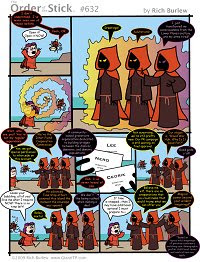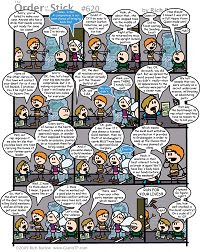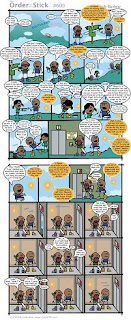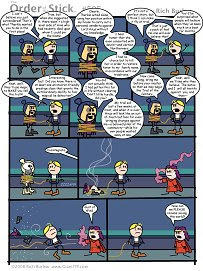(From The Order of the Stick. Click for full-sized wildest imaginings. This line would have been so much easier if I had nabbed the previous strip…)
Finally, we get to the first of my reasons for writing this series in the first place. And yes, this counts as this month’s OOTS post.
Recently Diamond Comics Distributors, which basically holds a monopoly on distribution of comic books, announced some changes in their policy that have the effect of raising the bar for what might be called “independent” comic books.
They’re certainly not good – nearly doubling the dollar amount a comic would have to sell in order to be guaranteed a continued listing in Diamond’s catalog – but it’s hardly the first time Diamond’s raised its bar. Something about this time, though, has convinced people – as though the previous times didn’t – that Diamond doesn’t care about the little guy and only exists to benefit Marvel and DC – if even DC. According to Diamond’s latest figures DC only makes up 31⅔% of the comic market, compared to 46% for Marvel – basically, Marvel has a little less than 1.5 times the share of DC. (On a dollar basis, the margin is roughly 41% to 30%, so Marvel makes a little over 1.25 times the money of DC.)
Have a look at the most recent monthly sales charts for December and be depressed by the parade of “DC” and “MAR” in the publisher column as you go down. You can count on your hands the publishers other than those two to place anywhere in the top 200, in order of market share: Dark Horse, Image, IDW, Dynamite, Avatar, Boom!, Aspen, and Abstract – and the latter four all first appear between #176 and #200, and only Dark Horse and Image get primo placement in the front of Diamond’s catalog along with Marvel and DC rather than being tossed in the jumble with the rest. Even more depressingly, Dark Horse and IDW owe a lot of their standing to their Buffy the Vampire Slayer and Angel comics respectively, with Dark Horse getting an added boost from Star Wars; outside of Marvel, DC, the Buffyverse, and Star Wars, the highest-ranking comic is Dynamite’s Boys… at #96 and a quarter of the sales of the top titles. Those are the companies – basically, Dark Horse, Image, IDW, and maybe Dynamite – that could survive if Diamond induced a contraction of the market to the point that it started having a practical constraint on the business of Marvel and DC, and there’s little practical reason to think that it couldn’t.
For numerous commentators, from Steven Grant to Christopher Butcher to Elin Winkler to Brian Clevinger, the latest changes are the last straw: it’s time for everyone else to bail out of the direct market as presently constituted, certainly in this economy, and move on to… something else. You could stay in the direct market and hop onboard the Image train and keep creative control while getting Image’s marketing savvy and catalog placement, but it’s far from impossible that Diamond contracts the market so much your title can’t get by regardless, and if it can Image becomes too conservative to publish it anyway. You could just do straight-up graphic novels, which as I mentioned earlier in the series are a form of infinite canvas compared to the 22-page monthly comic anyway, and send it to the bookstore market, but the bookstore market, as personified by Borders and Barnes & Noble, still has even higher barriers to entry, and still doesn’t give comics the respect they deserve. (When I went to Borders in Downtown Seattle to look for Reinventing Comics, the arrangement of the graphic novel section disappointed and disgusted me, with an explicit division between “manga”, “superheroes” and a single heading (rows include headings, which include shelves) of “other graphic novels”. Barf.)
Or you could go into a distribution mechanism where your presence is guaranteed even with a readership of zero… but where there’s little to no money to be had even with quite a bit of momentum.
Webcomics.com is STILL down, but in the comments to a post on New York Comic-Con (which for some reason I mistook for the infinite-canvas post I mentioned in Part III until checking Google’s cache right now, and may have made myself look like an ass in my own subsequent comments… oops, one way it’s a good thing Webcomics.com is down right now) Scott Bieser remarked that the new Diamond rules could lead to a mass exodus of “long-form” talent to the web, spawning not one but at least two posts (both down with the rest of the site right now) of advice to long-form creators on succeeding on the web. One of the two posts (the one that by all appearances went into greater detail) apparently was posted too soon to be indexed or cached by search engines before the site went down, and as it appears to be the more detailed one I’d like to see other webcomics bloggers’ take on this issue, but there’s still an interesting tidbit, worthy of further discussion, on the piece of it that I can see on one of the cache pages. I’ll get to that in a bit.
So, welcome to webcomics, comic-book refugees! Now that you’re here, what do you do?
First, before anything else, read Parts III and IV of this series and decide for yourself whether you want to go for the infinite canvas and join Scott McCloud’s revolution. If you do, you’ll probably learn more from McCloud’s books than you ever will from me, though I have a few important cautions in Part III. If you don’t, it’s worth it to read McCloud anyway.
Still here? That probably means you’ve decided not to pack your entire story into one installment that you read on a single page. That, in turn, means you’ve decided to put each page of your story – probably made to fit the 8½ x 11 format for easy printing later (or half-pages of that to fit on one screen, as McCloud proposes) – on one at a time. That, in turn, probably means you’re releasing comic book pages on a comic strip model, where you release one page at a time on a regular basis, and all the pages together make a single, coherent story. (You could release several pages at a time and change nothing, but…)
You’re probably going to need to unlearn much of what you learned about the comic book format.
Typically, learning from the ones that have come before you is a good place to start. Girl Genius is widely considered, if not the best, at least a significant trailblazer. Gunnerkrigg Court is worth studying too. But there are things both strips do that could trip you if you aren’t careful.
If you placed your hopes on the direct market in the first place, you’re probably used to the 22-page monthly “floppy” format (and in fact I’m assuming you want to make a story that continues indefinitely, rather than something that’s completely wrapped up in one book). That in and of itself is going to have to go; it’s now the individual pages that you’re going to be collecting in graphic novel form later. There’s no need to divide your story into neat 22-page chunks.
In turn, the way you think about those pages is probably going to be drastically different. You’re probably used to seeing the page chiefly as a part of the whole – understandably. But if you’re releasing those pages one at a time, your audience will experience them one at a time. Those pages have to stand on their own. You may be able to get away with massive, dramatic splash pages in print, but if that’s the only thing in that particular update, you’re giving your audience very little, and they may feel cheated. You have to move the plot substantially forward, or otherwise leave your audience satisfied, in every single update. (I don’t mean that you have to contort your story so every update has some sort of big dramatic cliffhanger, contrary to what some may have thought about my webcomics.com comment, only that you can’t have updates where nothing happens either. And if you’re going to have “cover” images for each chapter there damn well better be a VERY good reason.)
I touched on this issue when I reviewed Girl Genius, but it also applies to the Court, and what I said there bears repeating here: one “long-form” comic that seems to understand the difference between the webcomic format and the print comic format is The Order of the Stick. Even there, though, there are three caveats that make me wonder whether anyone has found the balance. OOTS is as much a humor comic as it is a “dramatic” comic, so Rich Burlew can and usually does fall back on a joke to end each comic; and two big parts of Burlew’s solution are piling on mounds of text and using the infinite canvas to extend an installment to two or even three pages if the story warrants.
(Also look at 8-Bit Theater, which hardly skates the first problem and doesn’t do much for the second, but never falls back on the infinite canvas to my knowledge. The Wotch is reliant on jokes but not too reliant on words.)
The latter approach, though, is one that you should definitely consider if all else fails – especially since the very fundamentals of how you write, especially pacing, may have to change to fit the web. Considering each page as an “issue” in and of itself means paying less attention to how they fit with each other (which is nonetheless still important, but becomes more akin to how each issue links with one another). In Reinventing, McCloud laments on the various contortions his story has to go through to fit the print format, such as stalling tactics. Such maneuvers won’t be entirely eliminated by the web if you’re not going whole-hog into the infinite canvas, but maintaining them for no good reason is a big mistake and will only be more noticable. You may find yourself restructuring your story to take full advantage of what the Web provides.
(But in all of this, remember that unless you’re already pretty successful, most of your audience will be reading your story all at once in an archive binge. Ideally, your comic should provide a satisfying read both on a one-at-a-time basis and all at once.)
There’s one more thing about translating a comic book to the web that bears mentioning, and it both ties in with what I’ve just said and serves as a segue to the next topic. Someone once said, “Every comic is someone’s first”. I had thought it was Julius Schwartz, then I thought maybe it was Mort Weisinger, now I see a source that claims Mark Waid. Regardless, it’s just as true in webcomics as it is in comic books, and that can be daunting when every page takes the role of what used to be a 22-page issue.
You could take steps to make every single page accessible to new readers, but it will probably force your comic to something closer to a humor comic and definitely will involve significant contortion to the story. More likely, if someone doesn’t want to binge through your entire archives, you can take steps to ease them into the story gently. Include recap pages to get new readers reasonably caught up on the story so far up to the start of the current chapter, or maybe even up-to-the-page updates. Eric “Websnark” Burns(-White) is insistent on the value of cast pages, even woefully out-of-date ones, in acclimating new readers into the comic as well. If your comic itself is done right, you can intrigue new readers into what’s going on right off the bat, while also piquing their interest on questions like “Hey, why is Character X acting like that towards Y?” and getting them diving into the archives to answer those questions and getting more questions, and eventually becoming completely hooked. (I finally became a fan of OOTS after being linked to a point just as the Azure City Battle was starting and it carried me basically to the then-current strip, and started me on an addiction to the rest of the archives.)
Building an audience is somewhat easier on the web than in the dog-eat-dog world of traditional comic books, but there are new parameters to keep in mind as well. Because there’s no solicitations, and you’re not a smaller part of the broader once-a-week habit of visiting the comic store, you have to set and keep a regular schedule for yourself to release each page. I recommend at least once a week, preferably more, or else it will drift from the memory of your readers. Even if you have an RSS feed, if you update too infrequently you may be asking your readers to do too much work to remember what came before. Select a certain set of days each week to update, such as Monday/Wednesday/Friday, and hold yourself to that, especially if you don’t have an RSS feed (or Twitter). 22 pages a month breaks down to 5-6 pages a week, but you may have to have less; you should have a substantial buffer if at all possible, and know the pace at which you complete each page and plan accordingly.
For several reasons I went over in Part III, but also because of some of the factors I mentioned in the preceding paragraph, webcomics have evolved under a comic strip model. Translating comic books to that format will necessarily involve some contortions. But is it necessarily true, as Tim Broderick claimed in the piece I can’t access even a cache of, that “long-form generally doesn’t attract as many readers on the web as short form”?
I don’t think so. There are certainly a good number of badly-done “long-form” webcomics, and comics where the necessary contortions may have produced an inferior reading experience. And long-form comics present a number of challenges that short-form comics don’t have to deal with. But comics that provide an unbroken thread of continuity from page to page offer one big advantage over “short-form”.
If you’ve been reading my webcomic reviews, you know that I typically take more kindly to a comic with a lot of continuity than a simple gag-a-day comic. Gag strips may give me a chuckle each day, but there’s little reason for me not to just read the day’s strip and be done with it, forever – no matter how much that day’s strip made me laugh. A gag strip doesn’t leave me waiting with baited breath for the next installment, waiting to find out if Vaarsuvius will finally say those prophesied four words that give him/her Ultimate Arcane Power. “Long-form” comics, done right, can attract a lasting readership less subject to certain ebbs, flows, and changing tastes than simple gag strips.
Broderick may be living in a time when long-form comics aren’t as popular as short-form ones, but with this key advantage, I think that as more long-form comics work out the kinks of how to work on the Web, the reverse will come to be true – especially with a potential explosion of new experimenters. Long-form comics may have to go through significant mutation to get there, but there’s a reason for all the short-form comics that have gone through Cerebus Syndrome.







